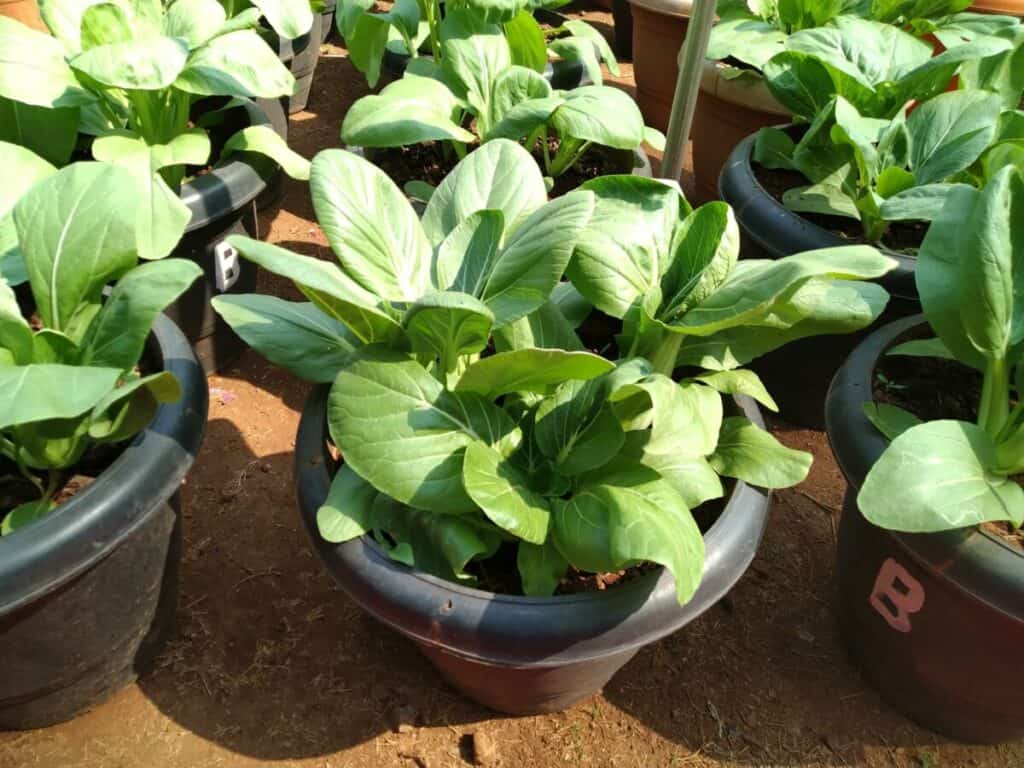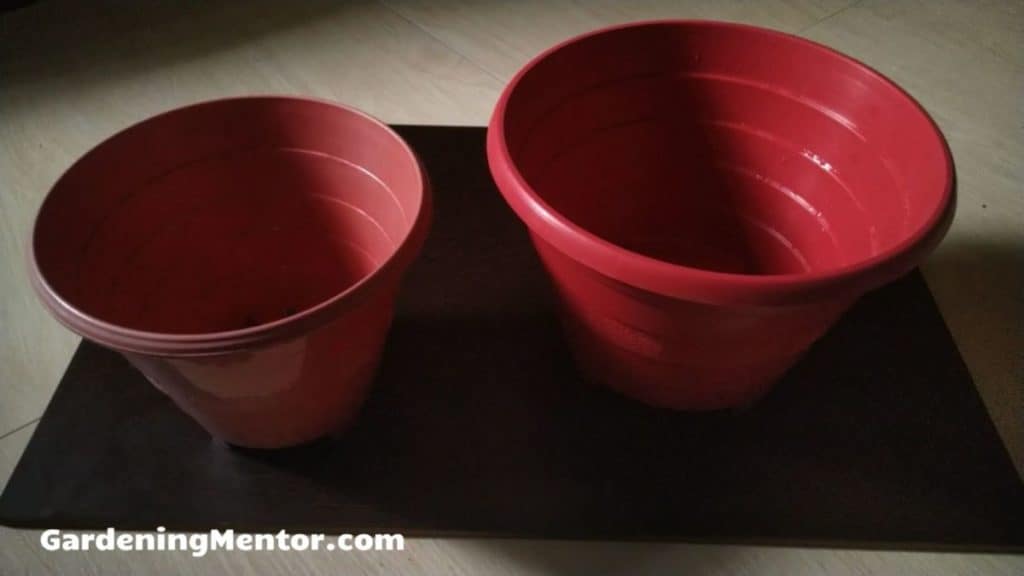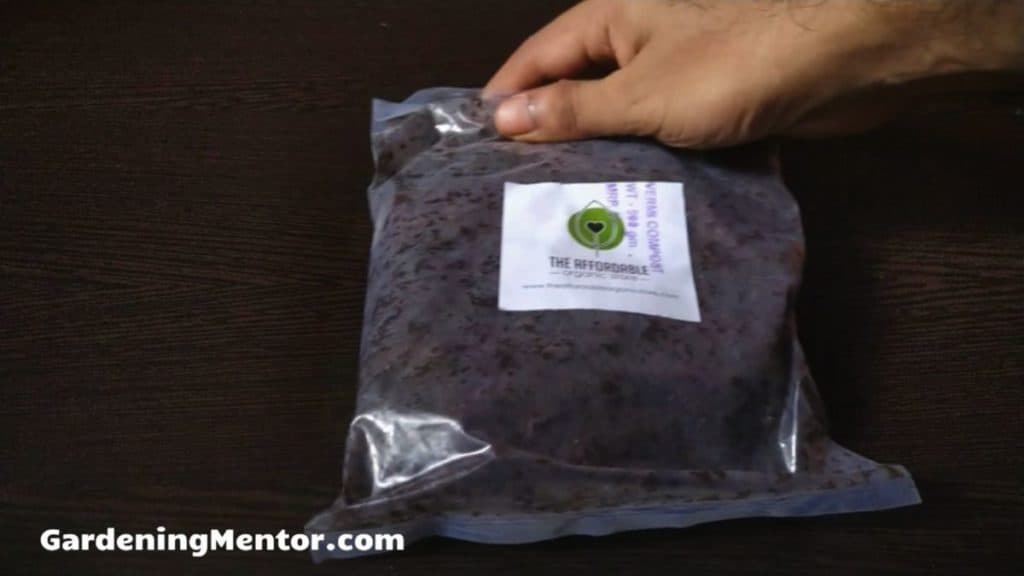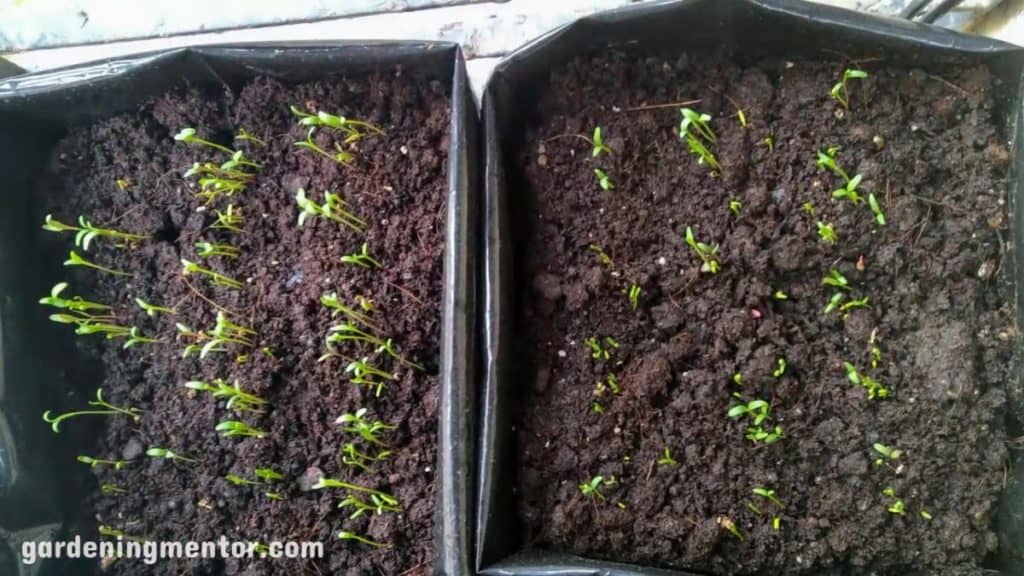One of the cornerstones of my container gardening will be a leafy vegetable. I chose spinach because it’s an easy plant to grow in a pot. This article will give you all the information I’ve researched growing spinach in your own container garden.
To grow spinach in a pot, choose a 10 inch pot with drainage holes. Fill it with nutrient-rich soil, leaving some space at the top. Sow spinach seeds about an inch apart and 1/4th inch deep. Water gently and keep the soil consistently moist. Place the pot in a sunny location, or partial shade in hot climates. Harvest the outer leaves as needed for a continuous supply of fresh and healthy spinach.
If you’re short on time and want a quick checklist to grow spinach in a pot, click the image below to download it.
What is spinach?
Spinach is a leafy vegetable that belongs to the amaranth family. It’s been used quite often in Mediterranean, Middle Eastern, and South-East-Asian cuisine.
It has dark, green leaves that are rich in nutrients. The flowers are small and yellow-green in color. The spinach plant can grow up to 1 foot tall.
You can use spinach raw or cooked in your food. Spinach is also preserved with canning or freezing techniques.
The raw and cooked form of spinach tastes completely different. You can use the raw spinach in your salad. And the cooked spinach works great in pasta, soups, and casseroles. It also makes a good addition to your sandwich or omelet.
What are some varieties of spinach?
Bloomsdale
The Bloomsdale is a spinach variety that has crinkled, dark green leaves with a thick texture. The plant can grow in full and partial sun.
The plant can grow up to 12 inches tall and takes about 40-48 days to harvest.
Double Choice
This is a spinach plant that you can use for baby leaves as well as the mature plant. The leaves remain tender and nutritious.
The plant can grow to a height up to 12 inches in just 35-40 days making it suitable to grow in a pot. It is a spinach variety that is resistant to leaf rust.
New Zealand
The New Zealand spinach variety is heat-resistant which means you can even grow it in summer without worrying about bolting.
The plant produces small, green leaves that are bittersweet making a good complement to seafood, chicken, eggs, and pasta.
This plant grows up to 12 inches in height and reaches maturing in 70 days’ time.
Baby’s Leaf
The Baby’s Leaf produces tender, dark green leaves that are suitable for your salad. The plant grows up to 12 inches in height and matures in just 30-40 days.
This makes it a very good spinach plant to grow in a pot where you can get full or partial sun.
Persius
Persius is a spinach variety that grows up to 8 inches in height and matures in just 35-40 days.
The leaves are smooth and dark green making them suitable to harvest as baby leaves or mature leaves. This plant is resistant to downy mildew and grows well in a container.
Space
The Space variety of spinach grows in just 35-40 days to a height of 12 inches. The leaves are smooth, dark green that is good in a salad or cooked.
This plant variety is heat-resistant and slow to bolt so you can grow it in spring, summer, or fall. It’s also resistant to downy mildew that other spinach plants may suffer from.
Malabar
The Malabar is an Indian variety of spinach that can grow even in hot and humid conditions. The leaves are thick and glossy with a taste that is close to mild Swiss chard.
This makes it a good choice for salads and stir-fry dishes. The plant is a vine variety that can grow up to 7 feet in length and matures in 60-80 days. This is a spinach variety that needs full sun.
Riverside
The Riverside is a spinach variety that can grow in spring, summer, and fall because it’s heat-resistant and slow to bolt.
The leaves are small and smooth making them easy to clean. They are also resistant to downy mildew.
The plant can mature in just 30 days for harvest and grows to a height of 6 inches.
Okinawa
Okinawa is not a true spinach but a perennial leafy green. It has a purple color on the underside of the leaves.
The leaves can be consumed raw or cooked and make a good addition to salads, stews, and tempura.
This plant is heat-tolerant and a native to Indonesia. It won’t bolt even if the temperature has increased a little in summer.
The plant can grow up to 28 inches tall and takes about 30-40 days to reach maturity. You can grow this spinach variety in full sun or partial shade.
Indian Summer
This is another Indian variety that is delicious and super productive. The plant is heat-tolerant and slow to bolt during hot weather.
It’s also resistant to many diseases that affect spinach plants. The plant grows up to 12 inches tall and matures in 35 to 40 days’ time.
Where can you buy spinach seeds?
You can buy spinach seeds from your local garden center or nursery. There are also a lot of online stores that sell several varieties of spinach seeds.
I’ve listed some of the spinach seed varieties you can buy along with the temperatures they need and the height they will grow.
| Seed variety | Temperature | Height | Days to maturity |
| Bloomsdale | 50-80 °F | 10-12 inches | 40-48 days |
| Double Choice | 50-80 °F | 10-12 inches | 35-40 days |
| New Zealand | 50-80 °F | 10-12 inches | 70 days |
| Baby’s Leaf | 50-80 °F | 10-12 inches | 30-40 days |
| Persius | 50-80 °F | 6-8 inches | 35-40 days |
| Space | 50-80 °F | 10-12 inches | 35-40 days |
| Malabar | 50-80 °F | 7 feet | 60-80 days |
| Riverside | 50-80 °F | 6 inches | 30 days |
| Okinawa | 50-80 °F | 26-28 inches | 30-40 days |
| Indian Summer | 50-80 °F | 10-12 inches | 35-40 days |
When is the best time to plant spinach?
Most spinach varieties are a cool-season plant which means they grow in temperatures ranging from 50 to 80 °F.
If the temperature is very low, the spinach seeds won’t germinate. If the temperature is above 80 °F, spinach will bolt. This means the plant starts producing flowers and seeds.
Since the focus of the plant has shifted from growing leaves to developing seeds, the leaves lose their taste and texture.
You do get spinach varieties that are heat-resistant and slow to bolt even if the temperature rises a little bit. You can plant such spinach even in the summer.
For most spinach varieties, the best time to plant is either spring or fall. This can be just after the last frost date or a few weeks before the first frost date.
Spinach grows pretty fast so you can harvest the leaves when they’re small as well as mature. You can have multiple harvests from one spinach plant during the growing season.
You can continue growing spinach in summer as well as long as the spinach is a heat-tolerant variety.

How to choose a pot to grow spinach?
You need to get a good-sized pot if you want to grow spinach especially if you’re going to grow more than one plant in one pot.
The spinach plant needs a container that is 6-8 inches deep. This depth is sufficient for the spinach plant’s roots to grow well.
The container width will depend on how many spinach plants you want to grow in one pot. If you want many plants, you’ll need a pot that is at least 18 inches wide.
The large width of the pot helps you grow several spinach plants together without them crowding each other and competing for resources.
You can get a pot made with different materials like plastic, terracotta, metal, ceramic, or concrete. I like to use a plastic pot because it’s lightweight, durable, inexpensive, and easy to move around. A grow bag works great as well to grow spinach.

Whether you use a new pot or an old one, make sure to soak it in a mixture of 1 parts bleach and 9 parts water for at least one hour. This helps remove the unwanted pests and diseases from the pot.
Rinse the pot well with water and dry it before you can start adding the potting mix and spinach seeds.
Spinach likes moist soil but it cannot do well in soggy soil. Make sure the pot has sufficient drainage holes at the bottom to remove the excess water.
I’ve researched some plastic pots you can use for growing spinach plants.
| Name | Width | Height |
| Countryside Planter | 18 inches | 6.5 inches |
| TABOR Planter | 16 inches | 6.5 inches |
| Bloem Planter | 19 inches | 7.5 inches |
| Fiskars Planter | 26 inches | 10 inches |
| Santino Planter | 15.6 inches | 6.7 inches |
Which potting soil should you use?
The best soil you can use to grow spinach is a neutral potting mix that retains sufficient moisture but drains out the excess.
You don’t want to use garden soil even if it’s easily accessible because it can contain harmful pests, diseases, and chemicals.
Fill the entire pot with the potting mix and leave just 1-2 inches from the top of the pot. This helps you water the spinach plants without the risk of the soil and water flowing out of the pot.
The spinach seeds will germinate in 5-10 days and you don’t need to add any fertilizer then. But once the seedlings grow after a few weeks, you will need to add some fertilizer.
If you use compost in the potting mix when starting, you don’t need any additional fertilizer. The rich, organic compost contains enough nutrients and microorganisms that help the spinach growth.

If you don’t have compost, you can add a slow-release organic fertilizer to the potting mix when preparing the pot. This fertilizer will release into the soil slowly after each watering you give. The fertilizer can be a balanced one with N-P-K values of 5-5-5 or 10-10-10.
Here’s a list of potting mixes that would be suitable for growing your spinach plants.
- Fox Farm Happy Frog Organic Potting Mix
- Burpee Natural Organic Premium Growing Mix
- Black Gold All Purpose Potting Soil
- Perfect Plants Organic Potting Mix
- Espoma Organic Potting Mix
How to plant spinach seeds in the pot
I like to plant the spinach directly in the pot instead of a seed tray as it grows fast and there is no need to grow indoors and then transplant.
Water the potting mix to make it moist before planting the seeds. You want it to be a little moist but not damp or soaking wet.
Place the spinach seeds in the soil at 2-3 inches from each other. You can place 2-3 seeds together because we can thin them later. You can then cover them with a little potting mix so the seeds are 1/4th inch below the soil.
Gently spray water on the soil so that it becomes moist. You want to keep the soil moist every day with such watering. The spinach seeds need the moisture to germinate after 5-10 days.
Where to place the pots?
Spinach plants can grow in full sun or partial shade depending on the variety that you’re growing. The full sun varieties need 6-8 hours of sunlight to grow well.
If you’re growing in spring or autumn you can place such varieties in direct sunlight as the temperature is low. But if the temperature increases in the afternoon, you will need to move the pot in a shaded area. Too much heat will cause the plant to wilt. The plant will also go to seed and bolt.
You can place the pots in a location of your container garden that receives direct sunlight. If the heat gets too intense like in the afternoon, you need to move the pots to a shaded location.
How to water spinach plants
Spinach plants prefer good moisture in the soil though they don’t like it to become soggy. Keep the spinach seeds moist with a gentle spray of water every day.
Once the seeds germinate, you can continue watering the soil so it remains moist. You do need to be careful not to overwater the spinach plant because too much water in the soil will drown the roots.
You can check the moisture level of the soil by putting your finger 1-2 inches into the potting soil. If the tip of the finger does not feel moisture, it’s time to water the soil.
Water the soil well till it drains out from the bottom of the pot through the drainage holes. This means that the water is reaching deep into the soil to the roots.
Rainwater is the best source for watering the spinach plants but the problem is you need to collect it. The next best option is distilled water if you have a distiller at home.
Most people, including me, can only use tap water and that is fine. But you need to keep the tap water standing in a container for one day before using it.
This helps dissipate the chemical like chlorine and fluoride that will be present in the tap water and can be harmful to the spinach plants.
I like to water the spinach plants in the morning so the roots can absorb the required moisture. When the sun comes out, it will dry out the soil due to the heat.
You don’t want to splash water on the foliage of the spinach plants because it makes them an easy target for fungal diseases like downy mildew.
Here’s a list of watering cans you will find useful for watering your spinach plants.
- Bloem Aqua Rite Watering Can
- Novelty Watering Can
- Cado Watering Can
- Gardener’s Select Watering Can
- Calunce Watering Can
How to thin the spinach seedlings
When you start spinach seeds in the pot, you plant 2-3 of them together. So at least one of them will germinate.
But if more than one seed germinates you have two or more spinach seedlings competing with each other. That’s why you need to use the thinning process.
Thinning means you need to cut out some of the 2-3 seedlings that may have germinated. You also need to cut out the seedlings that may be too close to another one leaving a few inches of space between the seedlings.
This helps the plants stay away from each other and avoid competing for nutrients. It also helps good air circulation so there’s less chance of a fungal disease.
The best time to start thinning the seedlings is when they have grown 2-4 inches tall. You can see a couple of the leaves have grown on the seedling.
From the 2-3 seedlings growing together, you can keep the one that looks the healthiest and cut out the remaining. Cut the seedling at the base with a pair of gardening scissors.
You can use the seedlings you cut out in your salad or you could add them to your compost pile if you have one.

Does spinach need fertilizer?
The best fertilizer for your spinach plants is organic compost. If you have some, you can add it to the potting mix when preparing the container.
Compost contains rich, organic matter that adds beneficial nutrients and microorganisms to the potting soil.
Once the spinach plants have grown for 4 weeks, you can add another batch of compost to the potting soil.
If you don’t have compost available, you can use a slow-release organic fertilizer instead for the same purpose. Add a batch to the potting mix when preparing the pot for the first time to plant the seeds.

And after 4 weeks, you can add another batch of the slow-release organic fertilizer to the potting soil. This fertilizer is released into the soil when you water the spinach plant.
Make sure to follow the instructions provided by the manufacturer on how much and how often to use the fertilizer.
You can also use a liquid fertilizer instead of the slow-release one. You apply this fertilizer directly to the soil and foliage making it fast-acting.
You can spray the liquid fertilizer every two weeks once the spinach seedlings have germinated and grown 2-4 inches tall.
The fertilizer you choose whether slow-release or liquid should be high in nitrogen which encourages the growth of new foliage. You could also use fish emulsion fertilizer to give your soil the boost of nitrogen for the spinach plants.
Avoid using too much fertilizer on your spinach plants because that will burn the roots and foliage of the plant.
Here is a list of slow-release organic fertilizer you can use.
Here is a list of organic liquid fertilizer you can use.
- Neptune’s Harvest Organic Fish & Seaweed Fertilizer
- Espoma Organic Grow Fertilizer
- FoxFarm Grow Big Liquid Fertilizer
How to protect spinach from weeds
Container gardening has the benefit that you don’t need to worry about weeds as much as when growing plants in the ground.
There will still be some weeds in your spinach plant pot due to the birds or wind carrying them over.
The best solution to the problem of weeds is to add a layer of mulch to the pot. This could be organic material like grass clippings from the lawn, dried leaves from the yard, or moss you collect near the house.
Allow the spinach seeds to germinate and reach 2-4 inches in height before you add mulch to the potting soil. The mulch blocks the sunlight from reaching the weed seeds in the potting soil and prevents their germination.
Another benefit of adding mulch to the container is it keeps the moisture in the soil to last longer. It slows down the evaporation of the moisture from the heat of the sun. And it regulates the temperature in the soil. So it remains cool and suitable for your spinach plants.
The mulch is made from organic material that slowly breaks down into the potting soil adding more nutrients to it. Materials like grass clippings and dried leaves used as mulch are a good source of nitrogen for the spinach plants.

How to harvest spinach
Spinach is a plant that you can harvest pretty fast. The plant grows mature leaves in about 40-50 days depending on the variety.
You can harvest the baby leaves when they are 2-4 inches big. Or you can wait till the leaves get even larger like 4-6 inches before harvesting them.
The more you harvest from the spinach plant, the more foliage it will grow. So keep harvesting as soon as the plant has a good amount of leaves for lots of spinach in the growing season.
Just make sure to only harvest 1/3rd of leaves from a plant at a time. This will leave enough on the plant to continue growing further.
Spinach leaves grow on the plant from the inside out. This means that the leaves on the outside mature faster than the inner ones.
So pick the matured leaves on the outside with either your fingers or a pair of hand pruners. Make sure not to pull on the plant when harvesting to avoid damaging the plant.
I would suggest adding some compost and potting mix near the base of the plants once you’re done with the harvesting. This will give the plants a boost to grow new foliage.
You can harvest the entire spinach plant just before it becomes too hot for the plant causing it to bolt and become tasteless. You can cut the entire plant at the base once it’s ready for harvesting.
Here are some hand pruners you can use for harvesting your cilantro plants.
- VIVOSUN Hand Pruners
- Fiskars Micro-tip Pruner
- GROWNEER Pruning Shears
- Felco Pruning Shears
- Corona Long Straight Snip
How to store spinach
If you can consume spinach as soon as you harvest the leaves, that will give you the best flavor and crispiness. Harvest the leaves only when you want to consume them.
If you do want to store the leaves, I will show you one way you can do this using your refrigerator. The spinach leaves will stay fresh for a couple of weeks with this method.
- Clean the harvested spinach stalks with water to remove any dirt from them.
- Place the individual stalks on a paper towel to dry them well.
- Separate out the leaves from the stalks. You can use the stalks in your cooking or dispose of them.
- Line a Tupperware container with a paper towel.
- Place the spinach leaves inside the container on the paper towel.
- Add a layer of paper towel on top of the spinach leaves.
- Close the lid of the container and store it in the refrigerator.
- You can take the required spinach leaves out of the container for your use in the kitchen.

Fact Checked, Written, and Published by Kevin Rodrigues
Kevin is the founder of Gardening Mentor, a website that aims to teach people to grow their own food in a limited space. As a self-taught gardener, Kevin has spent several years growing plants and creating gardening content on the website. He is certified in Home Horticulture and Organic Gardening from Oregon State University. He has a Post Graduate Diploma in Horticulture and Landscape Gardening from Mumbai University.
Read more

